1. The present situation of women’s script (Nushu女書)---Those who can write the script
Yang Huanyi (陽喚宣), a woman who was able to write Nushu in her girlhood and who was the last transmitter of Nushu, she died in September, 2004.
Zhou Shuoyi (周碩沂), a man who had been studying Nushu since the 1950s and was best at writing and reading Nushu, he died in October, 2006.
Zhou Shuoyi (周碩沂), a man who had been studying Nushu since the 1950s and was best at writing and reading Nushu, he died in October, 2006.
At present, there are six individuals who can write and read Nushu:
(1) Hu Meiyue (胡美月), a woman who learned a little about Nushu from her grandmother in her girlhood, but who soon abandoned its study. After her grandmother’s death, she resumed learning Nushu, filled with a sense of mission to preserve the script.
(2) HeYanxin (何艶新), a woman who was discovered by a researcher and who was inspired by this opportunity to recall the Nushu which she had learned in her childhood.
(3) He Chinghua (何静華)(woman)、He Xianglu (何祥禄)(man) and Tong Gongwei (唐功暐)(man): Individuals who began to learn Nushu after being stimulated by scholars’ research and who have become able to write the script.
(4) Pu Lijuan (蒲麗娟) (the daughter of He Chinghua何静華), a woman who studies and writes Nushu with a sense of mission to preserve the script.
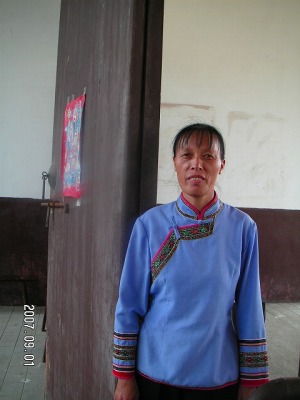
| 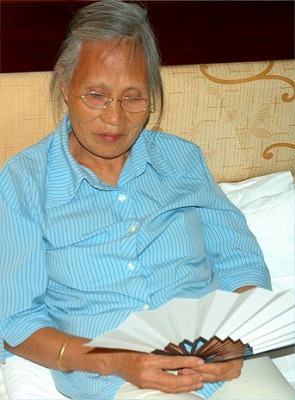
| 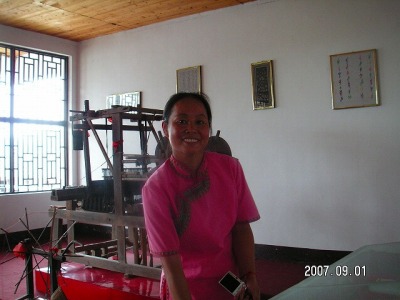
|
| Ms. Hu Meiyue | Ms. He Yanxin (photographed by Yuca Ishizuka) |
|---|
Among these men and women, it is only He Yanxin (何艶新) who can freely write what she thinks and feels as the women of earlier times did. She alone can read and write Nushu for communications among women and to express her thoughts and emotions, which is the original function of Nushu.We cannot help but conclude that the original forms and functions of Nushu have drawn near to their end.
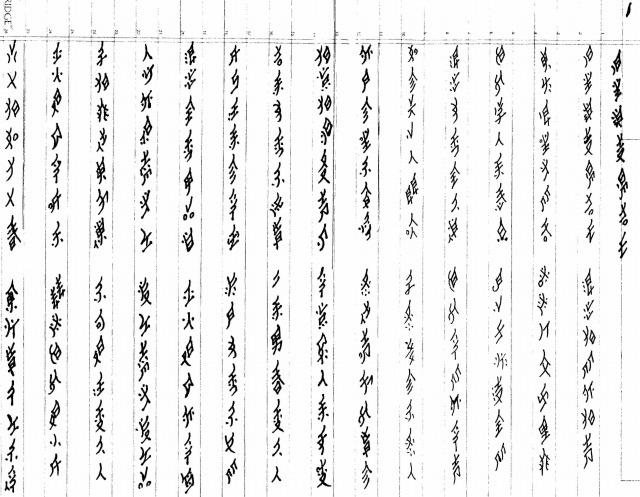
The new scripts of He Yanxin
In view of the situation, I wish He Yanxin to continue to write the original form of Nushu as long as possible, as it is vital for its preservation. She is able to write songs in Nushu replete with her own thoughts and feelings, just as women of previous generations. During the period of this field visit, she wrote some songs for us. However, unlike He Chinghua (何静華), He Yanxin (何艶新)lives in a village far from the seat of the prefectural office, so that she has few visitors and few chances to write Nushu. Visitors or people on inspection tour call on He Chinghua (何静華)to get her to write or read Nushu as if that were sufficient to capture the full richness of the script and its use. The women and me mentioned in (1), (3) and (4) above can write Nushu very beautifully. Their handwriting looks almost too beautiful. He Chinghua(何静華) knows many songs transmitted from old times, so she can compose her own songs by making use of or combining words used in such songs, but unlike He Yanxin (何艶新), she cannot make original songs based upon her own feelings. The other writers can make beautiful transcriptions of third-day missives (San Chao Shu三朝書) written by someone else, but they cannot compose their own soulful songs.
In the future, those like Hu Meiyue (胡美月) and Pu Lijuan (蒲麗娟) who learned Nushu for the purpose of preservation will continue to protect from complete extinction, but we have entered a very difficult era with respect to how to preserve and maintain the script, which has already lost its original function as a means of communication.
2. The Ford Fund
In 2006, the Ford Foundation in the U.S. decided to offer US$200,000 to China to support the preservation of Nushu. This was good news. Since I started my own field research, I have always stressed to Chinese government officials concerned how inevitable it would be that existing Nushu related materials would be dispersed before long and completely lost unless they collected them as soon as possible. However, their response was always said that there was no money to spare for the collection and preservation of Nushu materials when even the payment of the salaries of prefectural government staff was chronically delayed. But at last, money has come to them.
The outline of the Ford Foundation funding, as described by Liu Zhonghua (劉忠華), the general manager of the Nushu study administration center of the prefectural government, is as follows:
Four organizations – the Federation of Women’s Organizations, the provincial Agency for Cultural Affairs, the Jiangyong prefectural government (江永県), and Yongzhou city (永州市) -- had applied to the federation for support. The money (US$200,000, or about Y1,600,000) was shared among those four organizations, and 江永県received Y500,000.
The money from the Ford Foundation was given as a fund for the construction of (1) Nushu ecology museum and (2) Nushu database museum. For the former museum project, the plan is to repair and expand the Nushu garden founded by the prefectural government in Fuwei village, Jiangyong prefecture (江永県甫尾村) under the guidance of the prefectural museum. As for the latter proejct, Hunan University (湖南大学) plans to digitize original Nushu materials and make them open them to the public.
The prefectural government, however, has almost no original material, so it will be their task to collect them from now on. They will (a) conduct a field survey to collect original materials (b) visit researchers to ask them to provide Nushu materials, and (c) set up a room for each researcher on the home page of the prefectural government and make everything open to the public..
The field research was conducted from February through March, 2006, at a cost of tens of thousands of yuan.
The result of this research is as follows, according to Note 1 “Report on the field research of Nush in 2006” written by He Xianglu(何祥禄), who was a core member of the research group.
Note 1 “Report on the field research of Nushu in 2006” by He Xianglu(何祥禄) ( pp246-248 ) in “女書用字比較“ written by Zhao Liming (趙麗明) et al and published by 知識産権出版社
Research period: November, 2005 through April, 2006
Research area: 57 villages in total belonging to 江永県上江墟鎮、消浦鎮、銅山嶺農場、黄甲嶺郷、充山鎮and its surrounding 道県新車鎮、祥林舗鎮, etc.
Research group: 5 member: the deputy general manager of the prefectural advertisement division, another officer from the same division, a reporter from the prefectural TV station, the principal of 上江墟middle school, and He Xianglu (何祥禄).
Materials discovered and collected: third-day missive (三朝書)---3 volumes with characters, 10 volumes without characters, and 11 volumes that proved not to be genuine. Some Nushu works written by Yang Huanyi (陽喚宜)、Gao Yinxian (高銀仙) et al.
Sound recorded materials: 328 Nushu songs were recorded.
Works by Nuhong (女紅): women’s accessories, wedding articles, farming articles, and articles for daily use, etc.
Collection method: The research team visited more than 200 persons and had them sing and write in Nushu.
What ethnic group does this script belong to?
1) It was said that Nushu developed in an area where the Han (漢族) and Yao (瑶族) ethnic groups both lived together; Nushu recorded the indigenous language used on both banks of the river 潚水 (see Note 2). However, this language is one of the dialects of the Chinese language (漢語), and Nushu cannot record the Yao language (瑶語).2) Yao women’s status of Yao race (瑶族) both home and in society is higher than that of the Han women’s.3) This script is related to events in the lives of women in this area, and it was greatly affected by events and festivals of the Han people..
Note 2 This is the name of the river whose basin is 上江墟鎮.
For these reasons, the view that Nushu is the script of Yo (瑶族) women is not supported by the evidence.
As mentioned above, many useful materials and much critical knowledge were obtained through the field survy. It strongly supports the conclusion that the script is not that of the Yo (瑶族). There have been some who maintained that the script was developed by Yao (瑶族) women, because they wanted the script to be that of a minority group. However, it must now be concluded that the script did not originate among the Yo (瑶族).
As for the other field research, I feel the results were not worth the tens of thousands of yuan spent by the prefectural government, because of the superficial nature of the methods employed. My own research conducted so far together with my students has produced better results. More careful and minute research would produce better results.
The prefectural government’s research methods were reported by Xiao Ping (肖萍), the deputy manager of the Nushu administration center, to be as follows.
First, letters were sent to each village chief requesting the chief to investigate in advance whether there is any information about Nushu in the village. If an affirmative reply was returned, the research group visited the village to confirm the information about Nushu. In fact, some villagers free provided information, but in other villages, no one would sing a song in Nushu even if there were such songs or give information even if they had some information about Nushu.
Further, such prior information is requested only from the villages having a chief as the head of an administrative unit. On the surface, this way of conducting research looks efficient, since researchers go to the villages only to confirm information about Nushu where such information has been claimed to exist. There are, however, two big risks:
First, the prefectural government made their requests to village chiefs serving as heads of villages that are classified administrative units. In this area, however, there are many natural villages grouped under the village as an administrative unit (hereinafter referred to as “administrative village). A natural village forms like this. Originally some villagers who used to live in one village leave their village to live in some other area and build homes there; those houses cluster to become a new village. It is not an administrative unit, but it is an independent village. Natural villages are more numerous than administrative ones. Politically the administrative village seems to be different from the natural village, but there is no difference in villagers’ daily lives.
It cannot be said that all of the villages were fully researched if such natural villages are excluded. The researchers may have the excuse that since the natural villages were formed later, it is unlikely that there would be old Nushu materials, but this is not correct. Even if residents are new in new villages, it may be possible that they might have materials related to Nushu left by their grandparents or that they would know old residents in other villages.
Furthermore, I would like to comment on another aspect of this research method: requesting village chiefs to investigatein advance the existence of Nushu-related materials in the village and only visiting the village if a positive reply is given. This seems reasonable, but not all of the village chiefs are cooperative. At present, in this area, people’s memory of Nushu has become weak. And some village chiefs have little interest in Nushu. It is possible that such chiefs reported that they had no information in particular after making only the most perfunctory inquires. In March, 1996, for example, asked the chief secretaries of villages to collect information about Nushu. As a result, I found out that there were substantial differences in these officials’ interest in Nushu from village to village. I understood from that experience that research done by such village officials upon request is not so reliable.
And in fact, in one case, it turned out that a big treasure had been missed as a result of this way of doing research. In May, 1997, while I was doing field research in the villages, I discovered one volume of 三朝書in S village, which was owned by a man named H. He told me that he had received it from his 62-year-old mother named W who had come from 鳳田村.
In these volumes, words were typically written on three pages of 三朝書, but in the above三朝書, words were written on nine pages: three pages from the first page and six pages from the last page. It seemed that three women had written three pages each, and that those nine pages had been put together and made into one volume. I was very excited since I had found an original 三朝書. The chief of the bureau of the prefectural government tried to buy it, but the owner refused to sell it because it was valuable. He said that a year earlier, he had received an offer from 錦江to buy it, but he had not sold. The prefectural official then asked for permission to copy the volume, but the owner refused because copying would diminish its value. The owner said that a counterfeit would be made from its copy and the value of the original would decrease. We explained to him again and again that a counterfeit was a counterfeit and that the original would not decrease in value, but we could not persuade him. I the end, we were not allowed to copy the original.
Later, I received a report from He Xianglu (何祥禄)saying that he had conducted a large scale exploration in 57 villages. I asked him whether he had visited S village, but his answer was quite vague, so I went back to the village by myself.
There were four or five men at the entrance of S village, and I asked them to direct me to a person called W, but they said unenthusiastically there was no such person in the village. I proceeded into the village, and found a shop selling bean curd in an open space, where there were several persons.
I asked a woman who looked to be in her 70s, “Have you ever heard of Nushu and do you know a woman W.” Then to my surprise, she said, “I am W. I sold one volume of 三朝書last summer.” The following is our conversation:
I asked a woman who looked to be in her 70s, “Have you ever heard of Nushu and do you know a woman W.” Then to my surprise, she said, “I am W. I sold one volume of 三朝書last summer.” The following is our conversation:
Q: “To whom?”
A: “A person called Li (李), a school teacher.”
Q: “How much?”
A: “At 190 yuan.”
Q: “Oh, was your son unconcerned about that?”
A: “He didn’t know the fact because he has been working in Guangzhou (広州).”
Q: “In that 三朝書, were words written from both first and last pages?”
A: “Yes, that’s right.”
How amazing! The booklet was in the village until last year. I was not allowed to copy it when I found it ten years ago. The government field research was conducted through the end of 2005 into March, 2006. If the research had been properly done, this 三朝書 would have surely been discovered.
This village is a natural one, and thus was not targeted in the surveys done by the prefectural government. The vague answer by He Xianglu (何祥禄), indeed, hinted that they did not survey this village. It is not so far from the center of the prefecture and is on the way to other villages in 黄甲嶺郷. The road is not bad, so anyone can go by car. Even natural villages should have been included in the survey, and if the researches had visited every village carefully one by one, this village would have been included in the research. Unlike the situation in 10 years earlier, the son who had adamantly refused to permit a copy to be taken was away in another province for work, so that if the local government had asked his mother, they could have easily gotten the original or its copy. Even if she refused to sell it, it would have been easy to copy using a digital camera. In the event, the woman W had the booklet at the time of local government’s research, but it was sold later. How regrettable !
The prefectural government must to take its time to conduct field research thoroughly. Even if the prefectural government is to build a Nushu database museum or to enrich the Nushu garden, the data are too insufficient. They have almost no individual or original materials. There is no way to acquire them other than collecting them steadily. Since they were fortunate enough to receive Ford Foundation’s support, I urge them to conduct research guided by a detailed, plan devoting every available moment to their research, and using the funds effectively. They may now be able to search out any remaining available materials.
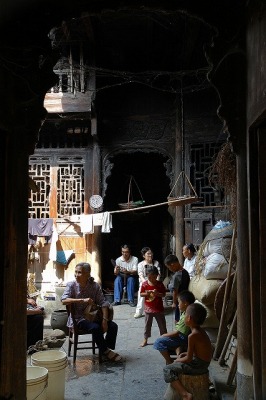 |
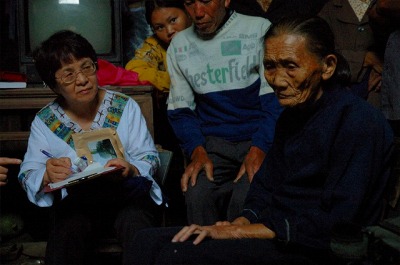 |
|
(photographed by Yuca Ishizuka) |
|
|---|---|
3. The Nushu Culture Village (女書文化村)
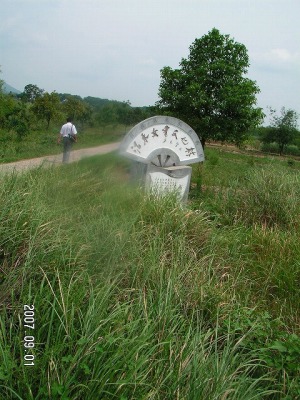
| 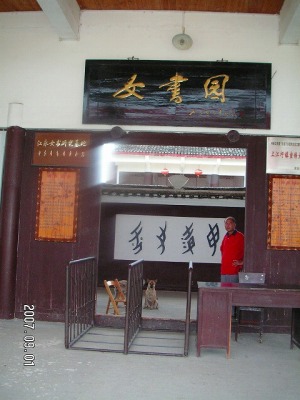
|
|
|
|
|---|
When I was crossing the bridge leading to the Nushu Culture Village, I found the handrails of the bridge broken in places. I was afraid that if many people crossed the bridge at the same time, they would fall into the river. There were also some holes in the aging bridge boards. When I visited this place five years ago, the bridge looked brilliant with red paint and was alive with many people. But the village looked much different this time. And both the walls and pillars of the building were rotten or broken, and I could not find any sign of repair at all.
Recently some officials of the prefectural government called the place “Nushu Garden”(女書園), but the name “Jiangyong Nushu Culture Village” (江永女書文化村) was written on the wall of the entrance.
The building was constructed by the prefectural government in 2002, and its management was left to Jiangyong Tourism Development Lt.(江永旅遊発展有限公司)organized by the Parket buisness group (Parket 筆克集団) in Hong Kong. I visited there in 2002 and 2004, and was surprised to see the dilapidated condition of the building in 2004. This time I found it much more decayed and deserted.
There is a small room on the left inside the building, where several photographs and pictures related to Nushu are on display. The next room is a kitchen used to prepare meals for the staff working there. The central room was used for a classroom teaching Nushu and has a fine tablet hung up that says “Nushu Study Room” (女書学堂). However, this time I found the room used as just an entrance hall. In the center, there was only a statue of a plump girl holding a writing brush seeming to write Nushu.
There is another room round the corner on the left from leading off the central room. Formerly it was used as a souvenir shop displaying many Nushu works and fancywork on the counter, but now I found that it had been transformed into a classroom. In the showroom on the second floor, old farming tools, a loom, etc. showing the life of the villagers of old were exhibited. I had no idea of how those articles were related to Nushu. There were no articles on display depicting the specifics of women’s life in those old times. The only Nushu-related articles were three volumes of 三朝書displayed in a small locked showcase. Pu Lijuan (蒲麗娟), the person in charge of the village, said that the 三朝書 had been blank until He Chinghua (何静華) wrote words on them. I was amazed to hear that. Since the booklet itself was old, visitors would think that the words were also written by a person long ago. Pu (蒲) knows that they were written by her mother, but others do not know the fact, so they would mistakenly believe that the booklet and the words are contemporaneous.
The garden was quiet. There was only a group of about ten tourists from a neighboring prefecture. I saw Pu Lijuan (蒲麗娟) explaining Nushu and its background to them in front of a graphic panel and singing some songs. Then she showed how to write Nushu. She explained that the letters of Nushu were phonetic symbols and one letter could express various meanings. She wrote some short sentences in Nushu and then transcribed them into Chinese ones.
In the vast garden there was no other visitor. Pu(蒲) said they received about 1,000 visitors a month at most and the admission fee was 30 yuan.
However, there was no exhibit to tell about Nushu itself, no list of characters, and almost no works on display. The museum had very few materials. With this level of exhibition and manner of presentation, it would be difficult to attract tourists from far away.
The prefectural government considers that to enrich the tourist facilities will lead to the preservation of Nushu, so they plan to reconstruct and enrich the Nushu garden using the Ford Foundation funding. The museum of Hunan province (湖南省) is to be in charge of the reconstruction. They seem to have already made a plan after experts exchanged ideas. The new Nushu garden would be much more substantial than the present one. To achieve the new plan, first of all, they must collect as many as possible Nushu-related materials for display.
While I was in the Nushu garden, no more people came than the aforesaid group of ten people. Even if the garden is rebuilt and enriched, I am afraid that the number of visitors would not increase tremendously.
In my opinion, before they make a strong effort to attract tourists, they should take good care of orthodox transmitters like He Yanxin (何艶新) and get her to write as many Nushu words as possible in order to preserve Nushu characters. Furthermore, they should make a strong effort to collect original materials to preserve the real form of Nushu. I sincerely hope that they will give priority to realizing these tasks.
Copyright© 1999 - 2007 Orie Endo.